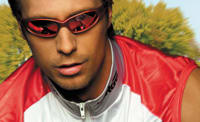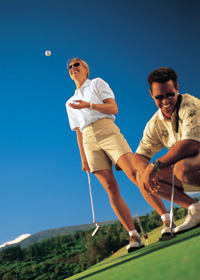TECHNICAL
SCORES
How prescription programs and lenses are giving dispensers
a competitive edge
By Marcy Bruch
Photography by Peter Baker
|
|
|
|
Rudy Project's Graal SX has interchangeable lenses, making it ideal for a variety of sports. |
|
EVEN though overall sunglass business has taken a hit due to the down economy, some savvy dispensers have found technical expertise gives them a definite edge--especially in the arena of sports sunwear. With more frame manufacturers offering to do lab work to make eight-base wraps Rxable, and consumers becoming more educated on the benefits of various lenses, the time has never been better for eyecare professionals to grab the ball and run--taking their sports sunwear business to the next level.
THE RX ADVANTAGE
An expertise edging lenses in-house for eight-base wraps, allowing his customers to wear sport-specific sunwear in their own prescriptions, has helped Bill MacGillivray, owner and master optician of North Portland Optical in Portland, Ore., tally 15 to 20 percent of his total sales from sports sunwear. "For a single vision prescription, I generally charge $60, making the average price for a frame and lens package about $295," he says.
SCORES
Maui Jim's Sport Titanium styles Wailea (left) and Kapalua (right)Fully committed to his athletic clientele, he has rebuilt part of his lab's edging machinery to accommodate these sport-specific frames. However, he advises dispensers who are just starting to explore opportunities in Rxable sports sunwear to take advantage of both wholesale labs and the growing number of frame manufacturers that offer prescription programs for their sport sunwear brands.
|
|
|
|
|
"If you're new to this technology, sending it out to the manufacturer's lab that has special equipment designed to accommodate their frames avoids a lot of costly mistakes and redos," he says.
Once a dispenser starts to build up his sports sunwear business, then learning lens- edging techniques for eight-base wraps and adjusting machinery accordingly may well be an option to take business to the next level.
Some dispensers learn this specialty lens edging by going to the manufacturer's lab. For instance, Bret Hunter, owner of Sports Optical in Lakewood, Colo., was one of the first dispensers invited to attend Oakley's lab course to learn how to edge their sport frames. Today, Hunter does all the work in-house and about 25 percent of his business comes from sports sunwear. Within that mix, much of the frames are in prescriptions.
"I have people come to me from all over the country to have their sports eyewear made up with their prescriptions. If they are on their way to a ski resort, they will make a detour here just for that purpose," says Hunter. In fact, both Hunter and MacGillivray have become such specialists in sports sunwear, they both sell sports-specific sunwear on the Internet. Hunter's site is www.sportsoptical.com and MacGillivray's Website is www.visiblespectrum.net.
MacGillivray has a prescription submission form on his site that explains how people can email or fax prescriptions. To make it easy for those shopping on the Website, he even breaks out sport-specific frames into the following categories: Golf, surf, cycle, snowboard, fish, ski, polarized, and football. "I just launched the site last year, but that's where I've seen the most sales increases. Business from that sector just keeps growing exponentially because now I have a national customer base."
DON'T FORGET KIDS
In Plainview, N.Y., Joseph Lerner, owner of Eyeglass House, says he's built a huge sports sunwear prescription business targeted specifically toward children. "With so many kids involved in sports like soccer, baseball, and basketball, parents want to make sure their eyes are protected. And if children are wearing prescription eyewear already, they want them to see clearly," says Lerner. "I only sell Siegel Optic kids six-base sport wraps imported from Europe. They meet OSA standards and retail for $240 with Transitions lenses," says Lerner. Since they are relatively expensive, more than 90 percent of these frames are sold with prescriptions.
Like MacGillivray and Hunter, Lerner has developed a wide following of customers that come to him specifically for this kids' prescription sport sunwear. "I'm the exclusive distributor of Siegel Optic kids frames in the United States, so that gives me a leg up on my competition."
|
|
|
|
Nike Interchangeable Treviso/R for Marchon Eyewear with a glare-cutting flash mirror coating. Shirt: Nautica Competition |
|
THE LENS EDGE
Since weather and light conditions can greatly effect an athlete's performance, one of the most important features of sports sunwear is the lens. Knowing that, dispensers that want to grow their sport sunwear business should make lens color options and finishes part of their presentation.
For instance, MacGillivray makes sure his staff thoroughly understands how various lens colors block light, enhance contrast, and heighten visibility in dark or cloudy conditions. MacGillivray and his staff show customers a three ring binder filled with lens samples that are divided into chapters for each sport. When helping customers choose sports sunwear, he also trains his staff to ask questions like: While you are engaging in this activity, are there certain types of lighting or atmospheric conditions that deter your vision?
The importance of how various colored lenses can enhance an athlete's performance is recognized even in sunglass specialty stores that sell plano eyewear. "Interchangeable lenses have performed phenomenally well," says Jeffrey Brody, owner of two Sunglass City stores in Marin and Fresno, Calif.
Brody's business is geared toward athletes, since 75 percent of his frames are sport and 25 percent are fashion. "Now that consumers are in a more conservative spending mode, they recognize how much bang for the buck they are getting when they buy a frame with three sets of interchangeable lenses.
Many of these frames have a general purpose light gray gradient lens set with flash mirror coating, a polarized lens set, and a yellow lens set to enhance visibility during dark or cloudy days," says Brody. Another added advantage to interchangeable lens frames: You can often order additional lens colors as well.
THE POLARIZED PUSH
Polarized lenses have been driving business lately, out-performing even fashion frames for Monica Sizemore, sunglass buyer for Cincinnati, Ohio-based Sunglass World, which has 110 locations.
"I have a sales force on the retail floor that really knows how to present the features and benefits of polarized lenses," she says. "We don't sell to the motor-cross bikers, or other extreme athletes. We sell to physically active adults who want sports sunwear suitable for a broad range of activities, be it golf, boating or running. So in that instance, a good pair of polarized lens frames--priced around $150--meets their needs perfectly."
Brody say she has also noticed that about 60 percent of his sport sunwear sales are coming from polarized product. Knowing that, he's made it easy for his customers to find them, since he tags each and every polarized frame with a yellow sticker.
|
|
|
|
Vuarnet kids style B800 in silver and matte black |
In Florida, where glare can be a real problem, Christopher Dunn, owner of Optical World in Naples always makes sure his frame boards are well stocked with polarized product. "I've seen a dramatic increase in sales of polarized sunwear just in the past year," observes Dunn. No matter what season, his boards will feature at least 150 frames with polarized lenses.
"If we're not constantly showing our customers that we have the latest and greatest, they'll simply walk away and find it someplace else," he says.
So whether you want to dive in and start offering your clientele extreme sport-specific frames with prescriptions, or just get your feet wet by adding frames with interchangeable and polarized lenses, doing so now could take your business to the next level.
LENS GUIDE
With so many interchangeable lens sport frames out there, here's a rundown of how various lens colors effect light conditions. This will help you recommend the appropriate lenses to an athlete so they can better enhance their performance--whatever the weather or time of day.
Blue: 12 percent light transmission. Ideal for bright light.
Red: Transmits 37 percent light and is best worn in variable weather.
Orange: Transmits 70 percent of light. Medium contrast lenses that are suitable for low to medium light conditions and are good for street wear or variable weather.
Yellow: Transmits 87 percent light while enhancing contrast and depth. Yellow attacks the shortest wavelength of the color spectrum (blue) to reduce optical "noise" like haze, mist, and smog. They are best worn during early morning light, during sunset, or during rainy days.
Transparent: These lenses transmit 97 percent light. And transparent lenses are best used to protect eyes from dust and debris during sports activities. They offer excellent protection in cold climates.
Polarized gray: Transmits 9.5 percent light transmission. Most popular color for sunglasses. Gray lenses allow the wearer to view the world in all its natural shades. Suitable for all light conditions and especially effective for glare reduction in bright sunlight.
Polarized brown: Transmits 12 percent light transmission. Brown lenses increase contrast and improve depth perception by managing the blue light spectrum.
Polarized green: Transmits 16 percent light. Works best in moderate to bright sunlight. Produces a transmission curve of light that is closest to the human eye.
Polarized rose: Transmits 18.9 percent light. Is especially suitable for moderate to hazy light since if offers the sharpest contrast. Used as cosmetic enhancement as well.
PRESCRIPTION PROGRAM RESOURCES
In addition to some wholesale labs, the following companies do the lab work for their sport sunwear styles either through prescription inserts or direct frame applications.
Oakley: Prescriptions available in most every frame style including eight-base wraps. Partnered with Varilux to offer progressive lenses in sport sunwear. For more information, call 949-951-0991.
Rudy Project: Offers both removable snap-in prescription inserts and direct in-frame applications. For more information, call 888-860-7597.
Bollé: This firm has partnered with Sola to offer some eight-base lens prescriptions. Offers prescription adapters for the Vigilante and Parole frame models. For more information, call 800-269-1537.
Marchon: Prescriptions available in select Nike six-base and eight-base models. Prescription range: +1.50 to -6.00 with cylinders to -2.00. For more information, call 800-645-1300.
Silhouette: Offers prescription adapters for selected Adidas sunwear shields and other styles. For more information, call 800-223-0180.
Maui Jim: Prescriptions currently available in single vision only and with a six-base curve. For more information, call 800-848-3644.
|
EYEWEAR FOR THE WEEKEND WARRIOR |
Besides gearing up with the proper golf club, tennis racket or snowboard, even casual athletes recognize the need for sunwear that will enhance their performance. Here follows Bill MacGillivray's rundown on sport-specific features and lens tints that will keep weekend warriors on top of their game.
Golf: Golfers need sun protection, depth perception, and superior color discrimination. For that reason, Macgillivray recommends sunwear that has brownish-rose lenses with a 28 percent light transmission during bright days because brown increases the green contrast of a golf course.
On hazy days, a brown lens with 50 percent light transmission works best. Rubber or silicone nose pads and temples help eyewear cling better to the face, even while perspiring.
Tennis: In order to make the fluorescent-yellow tennis ball pop out all the more, blue or brown lenses are recommended because their light wavelength makes the ball scream out of the landscape.
Frames should rest close to the face to protect from dust and wind. Frame material should also be lightweight--making plastic more appropriate than a heavy metal--so the player is comfortable during a grueling match.
Cycling and mountain biking: Serious bikers who fly along mountain trails and roads need glasses that will protect against wind and debris. Since they also rely on peripheral vision, the lenses must be distortion free. Blue lenses with flash mirror coating or polarization are ideal because they highlight contrast while riding in tree shadows.
The flash mirror cuts glare in bright sunlight, making them the best overall lens choice for variable light conditions. A clear or yellow lens is recommended for nighttime biking because is maximizes light and contrast. Eyewear must grip the face and be lightweight. Plastic wraps work best.
Water sports, including fishing, boating, rafting, and windsurfing: Lenses for water sport eyewear should eliminate both direct and reflective glare. Sailors, fishers, and swimmers need eyewear that blocks blinding light that bounces off water, and distorts vision.
For fishing in deep waters or whitewater rafting, Bill MacGillivray
recommends a dark gray lens with flash mirror coating or polarization to cut glare. For fly-fishing and other shallow-water fishing, he says a yellow polarized lens enables fishers to see to the bottom of water in early morning or in cloudy conditions. Lenses with hydrophobic coatings wherein water automatically beads off the surface are also a good for windsurfing, rafting, or canoeing. For swimmers and surfers, goggles, and eyewear retainers better hold eyewear in place.
Snow sports, including skiing and snowboarding: When a skier plunges down a mountain at 50 miles per hour, good vision is critical. That's why goggles are optimum for maximum wind and snow protection, but proper lenses play a part as well. Amber lenses with a flash mirror coating offer higher contrast to better see moguls because it blocks blue light from the sky.
The flash mirror coating reduces glare that bounces off the snow. Good venting systems keep lenses from fogging up. Prescription inserts in goggles are another added value benefit that enhances visibility.
Baseball, basketball, soccer, and hockey: Every time kids engage in high-impact sports, they put their vision at risk because their hand-eye coordination is still developing. That's why transparent goggles are the ideal protection for indoors.
For outdoors, a sleek eight-base wrap with lenses in red or orange for variable weather would work well. They should offer complete eye coverage, be heat-adjustable, and have a venting system to prevent fogging.
Mountain climbing, hiking: Avoid lenses that are exceptionally dark and have flash mirror coatings because they will cause sunburned noses. Lighter brown lenses are recommended because they enhance contrast.
Running: This is where interchangeable lenses are perfect to wear in variable light conditions. Gray, flash mirror lenses offer the truest color and yellow lenses are great for running in cloudy weather or at sunset.
Driving: Finally, while driving may not be a traditional sport, those behind the wheel still need to see clearly. MacGillivray recommends copper-colored photo-chromic lenses or brown polarized lenses because they filter out some of the blue light and they lighten or darken depending upon the atmospheric conditions for optimum visibility.
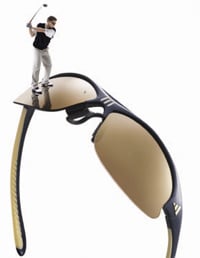
|
Golf: Adidas Pro Golf style 124 for Silhouette
|
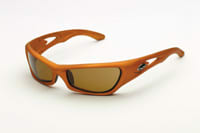
|
Tennis: Smith Optics style Folsom |

|
Cycling: Porsche style Speedster P3001 for Rodenstock |

|
Water Sports: Oakley's Water Jacket |

|
Skiing: Spy skiing goggles |

|
Soccer: Native eyewear style Nano |

|
Hiking: Timberland style T712 for Rem Eyewear |
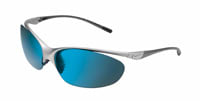
|
Running: Nike style Odeon for Marchon Eyewear |

|
Driving: Serengeti style Tanaga for Bushnell Performance Products |




